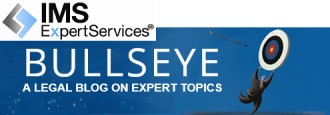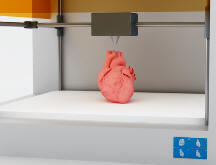

RF Cascade Workbook for Excel
RF & Electronics Symbols for Visio
RF & Electronics Symbols for Office
RF & Electronics Stencils for Visio
RF Workbench
T-Shirts, Mugs, Cups, Ball Caps, Mouse Pads
Espresso Engineering Workbook™
Smith Chart™ for Excel
|
 |
Printing a Verdict -- The Power of 3D Printed Evidence at Trial |

|

As a former Alabama trial and litigation attorney, Annie has a keen eye for expert evidentiary issues and
a clear voice for practical solutions. Annie is a published author of both fiction, non-fiction, and a comprehensive
legal practitioner's guide to hourly billing published by LexisNexis. Annie graduated from the University of
Alabama School of Law cum laude. While in law school, she served as Vice President of both the Bench and
Bar Legal Honor Society and the Farrah Law Society and was a member of the Alabama Trial Advocacy Competition
Team …
|
Reprinted with permission.
IMS ExpertServices periodically sends me e-mails that highlight recent key court cases that can significantly
affect the effectiveness of expert testimony, both for the plaintiff and for the defendant. You need only scan the
headlines I post daily to know the importance of effective legal representation when intellectual property (IP)
is being contested.
This article by Annie
Dike, writing for IMS ExpertServices, writes about a very unique and creative application in courtrooms for
the newfangled 3D printers: creating objects that jurors in patent infringement and product liability litigation
proceedings can hold in their hands and examine when considering a verdict. Her example includes creating exact
(or nearly so) copies of both the original and the contested versions of an invention in order to highlight the
similarities or differences, depending on whether you are a defendant or a plaintiff, of the two designs. This could
be a great strategy for you or your company if you ever find yourself in a similar situation; maybe you're there
right now. Be sure to send Ms. Dike a thank-you note if so.

Printing a Verdict -- The Power of 3D Printed Evidence at Trial
Posted by Annie Dike,
Esq.
"Do You, Google Earth, Swear to Tell the Truth?"
August 18, 2015 Can Google Earth make an assertion? Let's say in a trial over whether you went to work
today, you offer up a Google Earth satellite image that depicts you sitting at your computer typing away. Would that be an assertion that you were at your desk working this morning? Your boss may say the photo
could have been taken last week. But what if the image came with a date and time stamp and GPS
coordinates? Now that's proof. But, isn't that also a statement? Isn't it hearsay? When
faced with the same question, the Ninth Circuit said no. In a recent opinion over the arrest of an
illegal alien, a Google Earth satellite image was offered up by the Border Patrol to prove that the defendant
was arrested on the states' side of the United States-Mexico border. See U.S. v. Paciano Lizarraga-Tirado,
2015 WL 3772772 (9th Cir. 2015). The image also included a digital tack with GPS coordinates corresponding
to the coordinates the officer logged when the arrest was made. Hence the Google Earth image was
essentially an assertion that the defendant had indeed crossed the border and was arrested on United State soil.
Or was it? The Ninth Circuit, likening the Google Earth satellite image to a photograph found the image
itself was not an assertion because it was merely a depiction of a scene as it existed at a particular time.
You, sitting at your desk typing for example. However, the digital tack and GPS coordinates required
further analysis. According to the Ninth Circuit, these additions made clear assertions. Like the
date and time stamp on your work photo which assert that you were at your desk working at 10:34 a.m. But,
is an assertion hearsay? It depends on "who" said it: a human or a machine. The court
explained that topography lines added to an image by a human are hearsay because they are a person's written
assertion under Fed. R. Evid. 801(a). The Ninth Circuit joined its sister circuits in finding statements made by
a machine, however, do not qualify as hearsay under Rule 801. The question then was whether the digital
tack and GPS coordinates that were added to the Google Earth satellite image were made by a machine. The
court found they were. Even though a human enters the coordinates to pan to a certain location, he has no
role in finding and retrieving the image for the location. The Google Earth program handles this.
The tack is placed without any human intervention. Thus, the machine said it, so it is not hearsay.
Interestingly, the court did offer up, on its own initiative, a potential angle of attack for Google Earth
images: authentication. Because machines can malfunction or be tampered with, if a machine statement is
attacked on authentication grounds, the proponent of the evidence must prove accuracy of the process or system
which produced the statement. Meaning, if your Google Earth image is challenged, you would have to
establish Google Earth's reliability and accuracy. This could be done by bringing in a Google Earth
programmer. Unlikely. They probably all work out of a bungalow in the Bahamas. But, you could
also bring in an expert who frequently works with and relies on the program and can attest to its accuracy.
This may be a growing trend in the digital fingerprinting area. Our interactions and activities these days
are constantly logged in the digital universe. It may seem simpler than ever in this age to show when a
file was opened on your computer, where you had dinner last night or how much you transferred out of your bank
account yesterday. But, you may need an expert to help establish the accuracy and reliability of the
programs that log and track this type of digital information. If you need a witness with digital
fingerprinting expertise, IMS ExpertServices can locate them. Metadata experts can help you find, verify,
and defend the very types of digital evidence you may not have even known existed, but that can make all the
difference in your case. How about it readers, have you seen an increased use and reliance on
machine-generated statements in litigation? What types of challenges have you made to such evidence or
what obstacles have you seen it overcome? Respond when you have time, of course. For now, you better
get back to work. Google is watching.
What do you think Bullseye followers? Is 3D printed evidence something you want to explore? Have you seen it
used yet in trial? Do you find 3D evidence to be accurate or do you see the potential for it to be so graphic or
overwhelming that it might overcome reason? IMS is here to find experts, spot trends and listen to you. Let us know
what you think of this new 'printed persuasion' trend. ---
Add comments
This article was originally published in
BullsEye, a newsletter distributed
by IMS ExpertServices™. IMS Expert Services is
the premier expert witness search firm in the legal
industry, focused exclusively on providing custom expert witness searches to attorneys. To read this and other legal
industry BullsEye publications, please
visit IMS Expert Services' recent articles. For your next expert witness search, call us at 877-838-8464 or visit
our website.
Other IMS ExpertServices BullsEye and Expert Library Articles on RF Cafe:
Posted June 9, 2015
|

|

Copyright: 1996 - 2024
Webmaster:
Kirt
Blattenberger,
BSEE - KB3UON
RF Cafe began life in 1996 as "RF Tools" in an AOL screen name web space totaling
2 MB. Its primary purpose was to provide me with ready access to commonly needed
formulas and reference material while performing my work as an RF system and circuit
design engineer. The World Wide Web (Internet) was largely an unknown entity at
the time and bandwidth was a scarce commodity. Dial-up modems blazed along at 14.4 kbps
while tying up your telephone line, and a nice lady's voice announced "You've Got
Mail" when a new message arrived...
|
All trademarks, copyrights, patents, and other rights of ownership to images
and text used on the RF Cafe website are hereby acknowledged.
|
|
All trademarks, copyrights, patents, and other rights of ownership to images
and text used on the RF Cafe website are hereby acknowledged.
My Hobby Website: AirplanesAndRockets.com
My Daughter's Website: EquineKingdom
|
|
|


|










